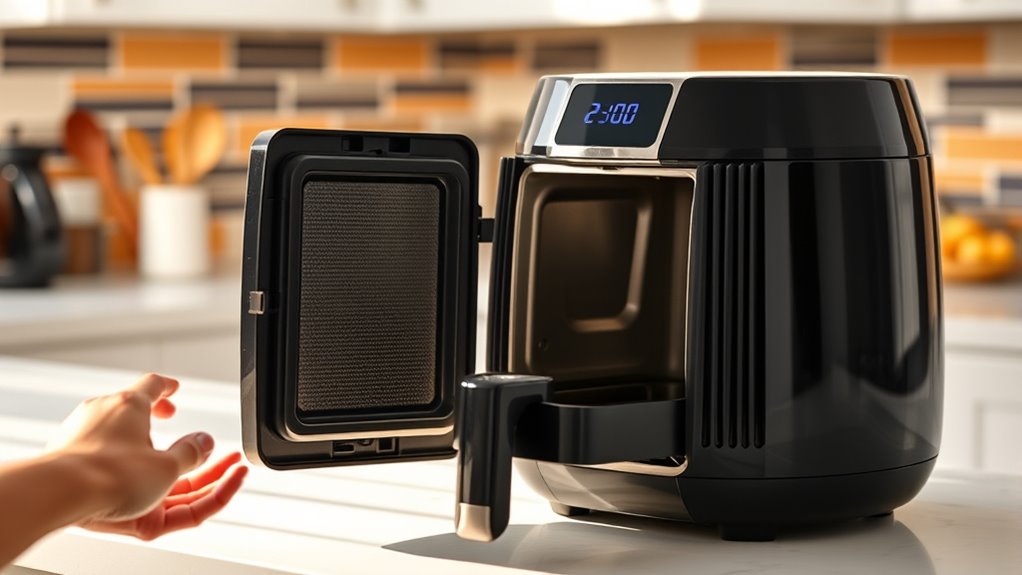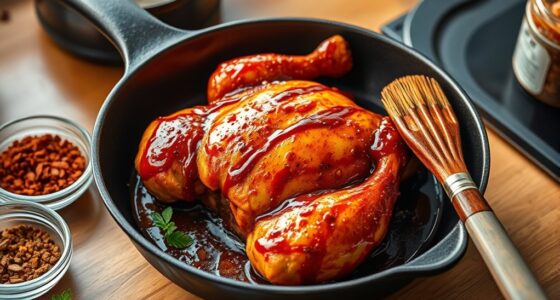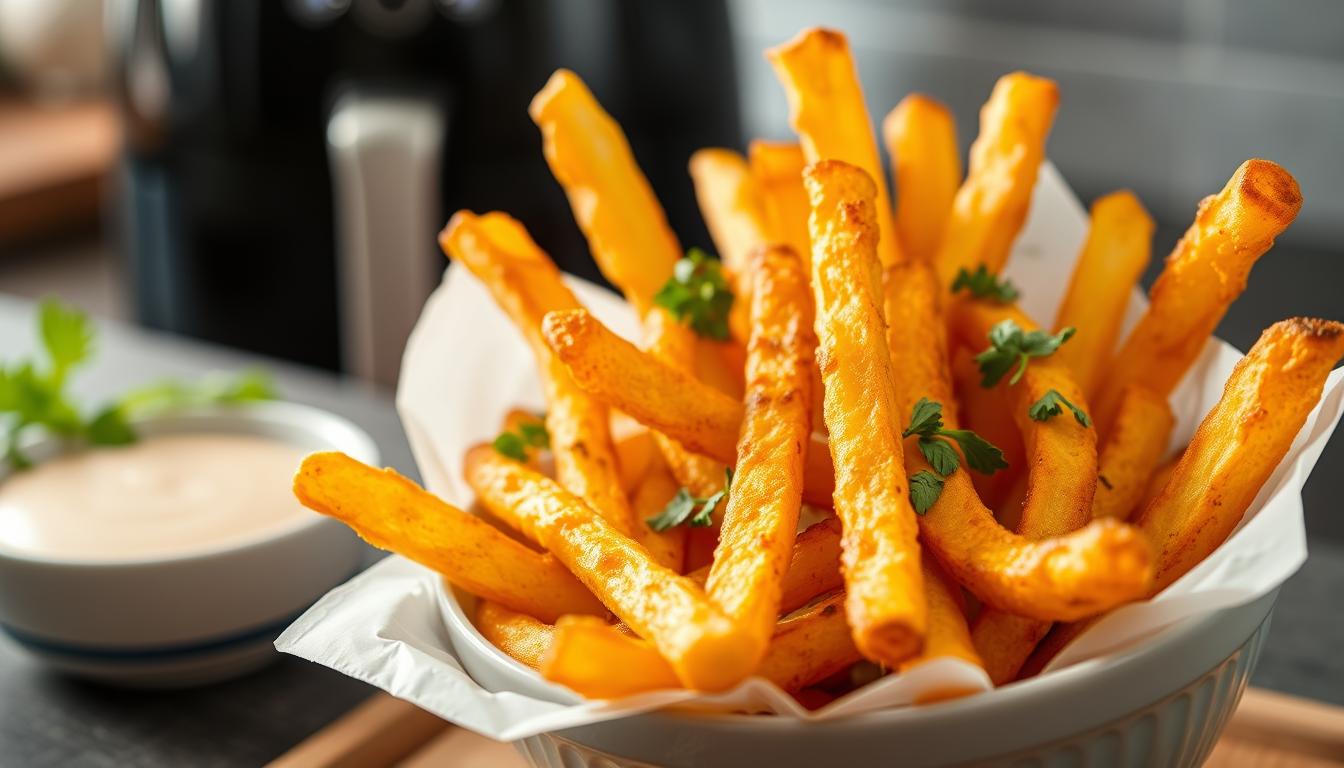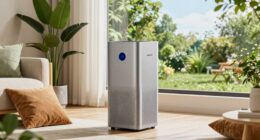Whether you should preheat your air fryer depends on what you’re cooking. Preheating helps make certain of even heat distribution, crispy textures, and better results, especially for baking, roasting, or high-heat dishes. For small or delicate items, you can often skip it to save time. To get the best possible outcome, understanding when preheating is vital and when it’s not makes a difference. Keep exploring for expert tips and tricks to perfect your air frying techniques.
Key Takeaways
- Preheating is essential for achieving even cooking and crispiness, especially for baking and roasting.
- For reheating leftovers or small, delicate foods, preheating can often be skipped without affecting quality.
- Preheating helps ensure consistent results and optimal texture by heating the air fryer to the desired temperature first.
- Skipping preheating may extend cooking time and lead to unevenly cooked or less crispy food.
- Always follow specific recipe guidelines, as some dishes benefit from preheating while others do not.
What Does Preheating Actually Do?

Preheating your air fryer helps guarantee that it reaches the ideal cooking temperature before you start adding food. When you turn it on and wait briefly, the appliance’s heating element warms up to the set temperature. This ensures your food begins cooking immediately at the right heat, helping achieve even results. Without preheating, your food may cook unevenly, with some parts overcooked and others underdone. Preheating also reduces overall cooking time because the air inside is already hot enough to start the process right away. Additionally, consistent temperatures during cooking are crucial for reliable results, which preheating helps facilitate. Proper temperature control enhances the crispiness and texture of foods. Fundamentally, preheating sets the stage for consistent, efficient cooking and better-tasting results. Incorporating advanced heating technology can further improve temperature stability and cooking performance.
Benefits of Preheating Your Air Fryer
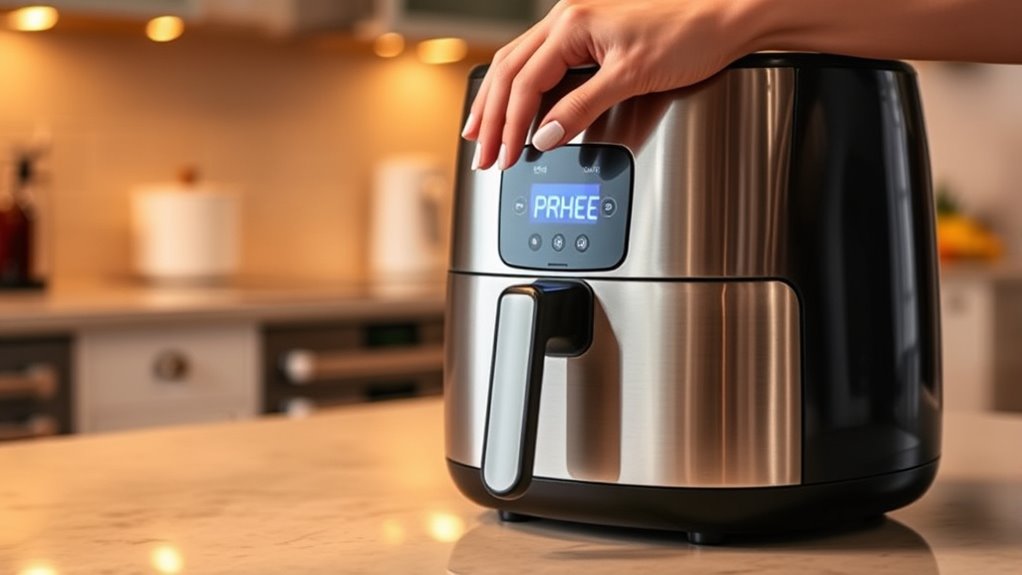
By preheating your air fryer, you open several key benefits that improve your cooking experience. First, it guarantees that food cooks evenly from the start, preventing cold spots and undercooked areas. When the appliance is hot, your food crisps up faster, giving you that perfect golden-brown texture. Preheating also reduces cooking time, saving you energy and making meal prep more efficient. Additionally, it helps achieve consistent results, especially for recipes like fries, chicken wings, or baked goods, where temperature plays a vital role. Without preheating, you might end up with unevenly cooked or soggy dishes. Overall, preheating enhances flavor, texture, and timing, making your air frying experience more successful and satisfying.
When Is Preheating Most Necessary?

Preheating is most essential when you’re baking or roasting dishes, as it helps guarantee even cooking and proper browning. If you’re cooking at high temperatures, preheating can prevent undercooked centers and uneven results. It’s also key when you want to achieve that perfect, crispy exterior on foods like fries or chicken wings. In some cases, tuning modifications can also influence cooking times and temperatures in specialized appliances, emphasizing the importance of preheating for optimal results. Additionally, understanding the educational value of your kitchen tools can help you better execute precise cooking techniques involving preheating. Recognizing the architectural significance of certain appliances can also inspire more effective cooking practices and appreciation for craftsmanship in kitchen design. Moreover, considering the performance features of your air fryer can guide you on when preheating may improve cooking efficiency and outcomes.
Baking or Roasting Dishes
When baking or roasting dishes in your air fryer, preheating becomes especially important for certain foods. If you’re cooking baked goods like cookies, cakes, or bread, preheating guarantees an even rise and proper texture. It also helps achieve a crisp crust on roasted vegetables or meats. Without preheating, your food might cook unevenly, leading to undercooked centers or soggy edges. For delicate items, preheating creates the right initial temperature to lock in moisture and flavor. When roasting or baking, a hot air fryer helps your dish develop the desired browning and texture quickly. Proper air fryer preheating ensures optimal results and better overall cooking performance. Additionally, understanding cooking techniques can help you optimize your results and avoid common pitfalls. Incorporating food safety practices is also essential to ensure your dishes are cooked thoroughly and safely.
Cooking at High Temperatures
Cooking at high temperatures makes preheating most essential because it guarantees your food starts cooking immediately at the desired heat, resulting in better browning and crispness. When you’re working with temperatures above 375°F, preheating ensures the air fryer reaches that temperature quickly, avoiding uneven cooking or undercooked spots. Without preheating, your food may sit in cooler air initially, which can delay cooking and affect texture. This is especially true for foods that need a quick sear or crisp exterior, like fries or chicken wings. Preheating at high temperatures also helps maintain consistent heat throughout the cooking process, giving you more control over the final result. Additionally, understanding interior design basics can help optimize your kitchen setup for efficient cooking. Proper kitchen organization can streamline your cooking process and ensure your tools are ready when needed. Being aware of your air fryer’s performance specifications can further enhance your cooking outcomes. So, for dishes requiring intense heat, preheating becomes a vital step to achieve ideal texture and doneness.
Achieving Even Crispiness
Achieving even crispiness hinges on proper preheating, especially for foods that benefit from a quick sear and a golden exterior. When your air fryer is preheated, the hot air circulates immediately upon adding your food, promoting uniform browning. This is essential for items like fries, chicken wings, or breaded vegetables, which require a crisp outside without overcooking the interior. If you skip preheating, you risk uneven cooking, where some parts burn while others remain soggy. Preheating helps establish a consistent temperature, ensuring each bite is perfectly crispy. While not always mandatory, preheating is most necessary when aiming for that ideal, restaurant-quality crunch. It’s a simple step that greatly improves the texture and overall quality of your air-fried meals. Additionally, understanding cooking techniques like preheating can elevate your culinary results and help you achieve consistently delicious dishes. Proper preheating also ensures even heat distribution, which is crucial for achieving consistent results across different recipes.
Situations Where You Can Skip Preheating

There are certain situations where skipping preheating won’t affect your results. If you’re cooking foods that don’t require a crispy exterior or quick heat transfer, like baked goods or reheated leftovers, preheating isn’t essential. For example, when warming up bread, muffins, or casseroles, you can toss them straight into the basket without preheating. Additionally, if you’re cooking small, thin items like frozen fries or chicken wings, some models heat quickly enough that preheating may not *considerably* impact the outcome. In these cases, skipping preheating can save you time without sacrificing quality. Just remember, for foods needing a crisp crust or specific texture, preheating remains beneficial for best results. Moreover, certain candle making techniques can benefit from preheated environments to ensure proper melting and mixing, but for many everyday dishes, it’s often unnecessary. Understanding the thermal properties of different foods can help you decide when preheating is truly needed.
How to Properly Preheat Your Air Fryer
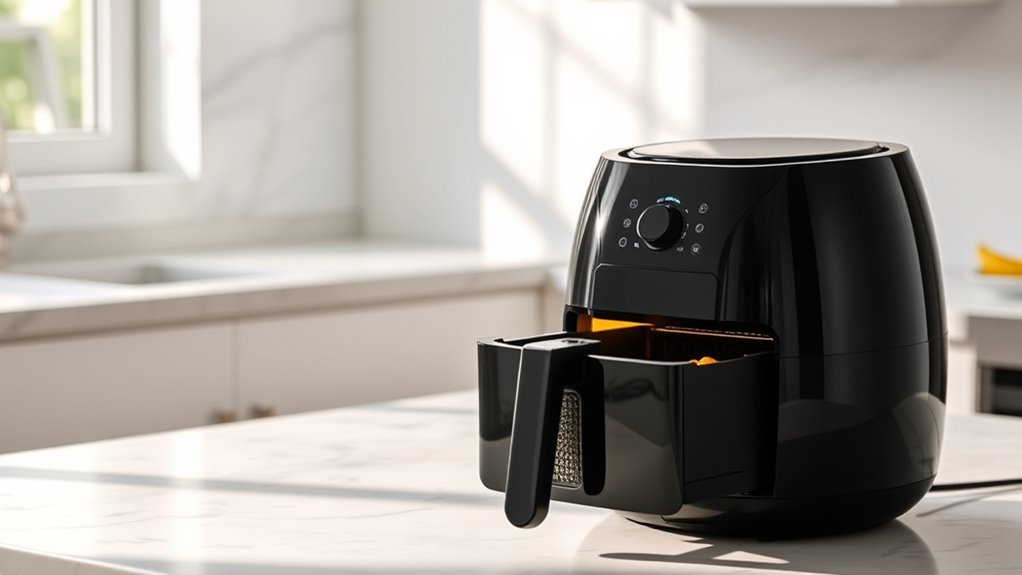
Preheating your air fryer properly guarantees that your food cooks evenly and achieves the desired texture. To do it right, follow these steps:
- Set the temperature: Turn on your air fryer and set it to the recommended preheating temperature, usually around 350°F to 400°F, depending on your recipe.
- Let it run empty: Allow the air fryer to run for 3-5 minutes to reach the target temperature, ensuring the interior is fully heated.
- Use a thermometer if needed: For precision, use an oven-safe thermometer to confirm the air fryer reaches the desired temperature before adding your food.
- Proper preheating can also improve energy efficiency by reducing cooking time and ensuring consistent results. Additionally, understanding penetration testing and other security practices can help safeguard your smart appliances from vulnerabilities.
- Regular maintenance and cleaning of your air fryer can enhance its performance and longevity, ensuring it operates at optimal efficiency every time. Proper preheating not only improves cooking results but also helps in identifying potential malfunctions early on, maintaining safety and efficiency.
Proper preheating guarantees consistent results and crispy textures every time.
Common Mistakes and Myths About Preheating

Many people believe preheating is always necessary, but that’s not true for every recipe. Some think preheating speeds up cooking considerably, but it doesn’t always make a difference. You’ll also want to avoid common mistakes like over-preheating or skipping the step altogether.
Preheating Not Always Needed
While preheating can improve results for some recipes, it’s not always necessary and is often a common misconception. Many believe that skipping preheating ruins the dish, but that’s not true for every situation. In fact, some foods cook just as well without it, saving you time and energy. For example, low light office plants can thrive without preheating your air fryer, just like they do in dim indoor conditions. Consider these points:
- Cooking smaller or delicate items often doesn’t require preheating, as they cook quickly and evenly. Proper temperature control can be more important than preheating for such foods.
- Frozen foods can sometimes benefit from starting cold, which helps prevent over-browning.
- Longer cooking recipes may not need preheating, especially if they are cooked at lower temperatures for extended periods.
Understanding when preheating is essential helps you cook more efficiently and avoid unnecessary steps.
Myth: Faster Cooking Times
Despite the belief that preheating speeds up cooking, it doesn’t always lead to faster results. Many think that preheating will cut cooking time substantially, but that’s not necessarily true. In some cases, preheating can actually extend the overall cooking process, especially if your food is already close to the desired temperature. The air fryer heats up quickly, so adding food once the interior reaches temperature can be just as effective as waiting for a full preheat. Rushing into cooking without preheating won’t ruin your meal, and in fact, sometimes it’s better to start cooking sooner. Remember, preheating is mainly about ensuring even cooking and better texture, not necessarily saving minutes. Don’t fall for the myth that preheating always makes your meals faster.
Common Preheating Mistakes
Preheating your air fryer is straightforward, but common mistakes can undermine its effectiveness. First, many skip preheating altogether, which can lead to uneven cooking. Second, over-preheating by leaving it on too long wastes energy and may burn food. Third, not using the right temperature setting for preheating can delay the process or result in under-heating. To avoid these errors, always preheat for the recommended time, usually 3-5 minutes, and stick to the proper temperature for your recipe. Remember, preheating isn’t just a step; it’s vital for achieving crispy, evenly cooked results. Being mindful of these mistakes ensures your air fryer performs at its best and helps you get the best dishes every time.
Tips for Achieving Perfect Results Without Preheating

You can achieve great results in your air fryer without preheating by adjusting your cooking times and temperatures. Since the appliance is already at cooking temperature, you might need to extend or reduce cooking duration depending on your food. For example, thicker items may require a few extra minutes, while delicate foods benefit from shorter cooking times. Use lower temperatures for tender items and higher for crispy results. Keep an eye on your food to prevent overcooking. Here’s a quick reference:
| Food Type | Adjustments |
|---|---|
| Frozen fries | Add 2-3 minutes, increase temp slightly |
| Chicken breasts | Reduce time, maintain temp |
| Vegetables | Shorten cooking duration |
| Baked goods | Slightly lower temp, watch carefully |
| Seafood | Use shorter times, delicate handling |
Frequently Asked Questions
Does Preheating Affect Cooking Time Significantly?
Preheating your air fryer can influence cooking time, especially for recipes requiring crispy textures or precise results. When you preheat, the appliance reaches the ideal temperature faster, reducing overall cooking time. Without preheating, your food might take longer to cook evenly. So, preheating isn’t always necessary but can save you time and improve results, depending on what you’re preparing.
Can I Preheat My Air Fryer With Food Inside?
You might wonder if you can preheat your air fryer with food inside. It’s best to prevent doing so, as the hot air circulates unevenly around the food, leading to inconsistent cooking. Imagine placing cold chicken in a preheated oven—same principle. For best results, remove the food, preheat the fryer, then add your ingredients. This way, you guarantee even cooking and perfect crispiness every time.
How Long Should I Preheat My Air Fryer?
You should preheat your air fryer for about 3 to 5 minutes before cooking. This helps guarantee even heat distribution and crispy results. If you’re cooking items that need a crispy exterior, preheating is especially beneficial. Keep an eye on the temperature, and once the air fryer reaches your desired setting, add your food promptly to maximize efficiency and achieve the best texture.
Is Preheating Necessary for All Types of Foods?
Imagine biting into perfectly crispy fries or tender chicken, craving that flawless texture. You wonder if preheating your air fryer is essential for every food type. The truth is, it depends. For foods needing a crispy exterior or quick cooking, preheating makes a big difference. But for others, like reheating leftovers or delicate items, skipping preheat can save time without sacrificing quality. Knowing when to preheat elevates your cooking game.
What Are the Energy Implications of Preheating?
Preheating your air fryer can slightly increase energy use since it involves running the appliance longer before cooking. However, it can also save energy by reducing cooking time and ensuring more efficient heat transfer. If you preheat only when necessary, like for crispy textures or even cooking, you balance energy consumption effectively. Ultimately, preheating may cost a bit more upfront but can lead to overall energy savings.
Conclusion
So, should you preheat your air fryer? It’s a choice that can transform your cooking results, making everything crispier and more evenly cooked. But skip it, and you might wonder if that crispy perfection is just a preheat away. The secret lies in knowing when to preheat and when to trust your instincts. Ready to access that perfect crunch? The answer might surprise you—are you prepared to take your air frying to the next level?
